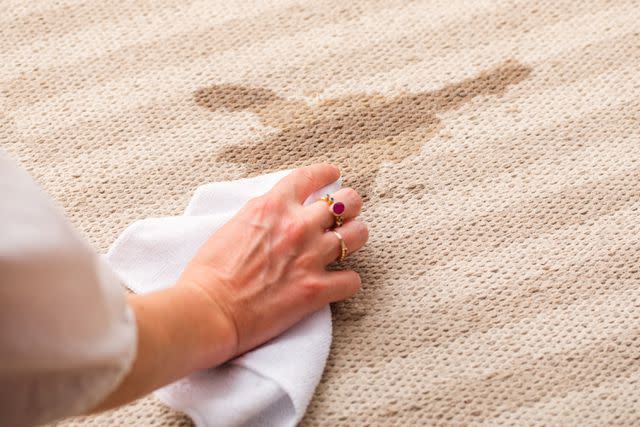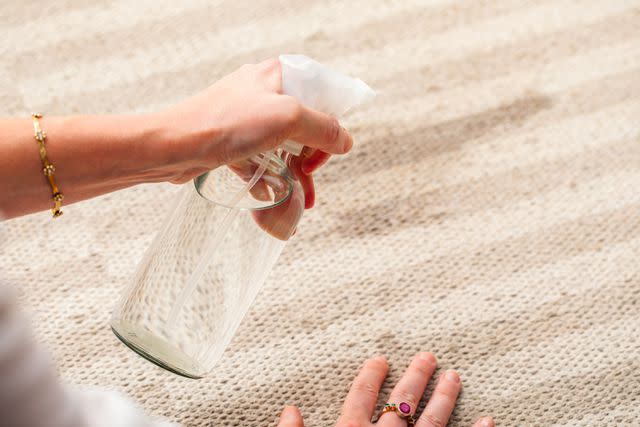How to Get Stains Out of Carpet, No Matter What Type
These simple cleaning tips and go-to carpet stain removers make it easy to eliminate stubborn stains from coffee, dirt, red wine, and more.
Fact checked by Emily Estep
Carpet delivers cozy softness and added warmth underfoot, but it can also make your floors susceptible to stains. Even a home without kids or pets is prone to the occasional spill or smudge, which can quickly seep into the fibers and become a set-in stain. Knowing how to get stains out of carpet successfully might sound daunting, but stubborn spots lift out easily with the proper technique and cleaning solutions.
No matter what kind of spill you're dealing with, the process for removing carpet stains generally remains the same. Follow the three simple steps below to learn the basic carpet stain removal technique. Then, read on for specific tips on removing some of the most common carpet stains, including chocolate, coffee, dirt, red wine, and more. Once you learn how to get stains out of carpet from these experts, your carpet will soon look as good as new without needing professional carpet cleaning.
Related: The 14 Best Carpet Brands of 2024 for the Perfect Home Floors

BHG/Sarah Crowley
How to Get Stains Out of Carpet
You worked hard to remind people to remove their shoes and avoided bringing food into your carpeted rooms. And then it happens: the coffee spill or the flying gravy boat at Thanksgiving. Before reaching for the nearest bottle of cleaning product, remember that the best choice is often water. Blot (don't rub) the stain with a clean, slightly damp white cloth.
If plain water doesn't work, move on to a carpet stain remover or DIY solution. The best method for how to get stains out of carpet will involve the right cleaning solution for what caused the stain.
Step 1: Remove excess ASAP.
Scrape off any excess solids with a spoon or a butter knife as soon as possible so your cleanable spill doesn't turn into a permanent stain. Gently blot away excess liquid with a clean, white, absorbent cloth ($5, Target), working from the outside edge of the stain toward the center to prevent spreading. "Always blot, never rub, which can permanently damage carpet fibers," says Derek Christian of My Maid Service. Repeat until the cloth no longer picks up any color.
Related: The 8 Best Carpet Cleaners for Pets

BHG/Sarah Crowley
Step 2: Apply a carpet stain remover.
Spray any remaining stain with a carpet stain remover, following the manufacturer's instructions for application. You can also clean the carpet with a vinegar solution. For a homemade carpet stain remover, stir 1 teaspoon of mild dishwashing liquid into 1 quart of warm water, add ¼ teaspoon of white vinegar, and apply to the carpet stain. No matter which carpet cleaner you use, don't over-wet the stain, which can damage the backing. Let sit for 10 minutes.
Editor's Tip
Always test for color fastness in an inconspicuous spot before applying a carpet stain remover.
Step 3: Blot stain away.
Using a clean, white, absorbent cloth, blot from the outside in. Repeat until the stain no longer transfers to the cloth. Blot with cold water, then blot dry. For thorough drying, try this trick: Cover the damp area with a ½-inch-thick layer of cloth or paper towels. Weigh them down with a heavy object and change out paper towels until dry.

How to Get Stains Out of Carpet: The Top Offenders
For common carpet stains, try these solutions.
Blood
Avoid using warm water to clean blood stains on carpet, as this will help the stain adhere to the material. Apply cold water or club soda, then blot with a clean cloth. Repeat until the stain is gone.
Candle wax
For how to get stains out of carpet caused by candle wax, rub an ice pack on the wax until it hardens. Gently break up the wax, then vacuum up the pieces. Treat the spot with a carpet cleaner, following the manufacturer's instructions, or a white cloth dampened with a small amount of rubbing alcohol. Blot the area to dry.
Chocolate
Use a dull knife to scrape away as much solid material as possible to remove chocolate stains on carpet. If the chocolate is melted, place a resealable plastic bag filled with ice cubes over the stain to harden the remaining chocolate before scraping. Vacuum the area to pick up any loose flakes or pieces. Mix ¼ teaspoon of liquid dish soap with 1 cup of warm water, and use a clean cloth to apply the solution to the stain, working from the outside toward the center. Leave the solution on for at least five minutes, then blot until the stain is gone.
Related: The 8 Best Handheld Vacuums of 2024, Tested and Reviewed
Coffee or tea
To get coffee or tea stains out of carpet, cleaning expert Melissa Maker recommends mixing 2 tablespoons of hydrogen peroxide with 1 tablespoon of dish soap. Blot the spill first, then apply the solution. Let it sit for a few seconds before carefully working in the solution with your fingers. Rinse the stain with water, blot, and repeat until the stain is removed.
Dirt
Allow dirt or mud stains on carpet to completely dry before treating. Scrape off as much residue as possible, then vacuum. Apply a detergent solution (such as the mild dishwashing liquid, warm water, and white vinegar solution outlined above). Let the solution sit on the stain for 10 minutes before blotting with a clean white cloth or paper towel.
Fat-based stains (butter, margarine, gravy, etc.)
Use baking soda as a carpet cleaner for fatty stains. Sprinkle the stain with baking soda and let it sit for six hours. Vacuum and then blot with a cloth moistened with rubbing alcohol. You can also use a dry-solvent spot carpet cleaner, ($17, Lowe's) following the label instructions.
Wine or Juice
Whether you spill red wine, white wine, grape juice, or another vibrant beverage, start by spritzing with club soda. Blot with a clean microfiber cloth. Repeat until the stain is gone.
Gum
Peel away as much gum as you can. Harden the remaining gum by placing a resealable plastic bag of ice cubes over it. Chip gum away with a spoon or dull knife. Vacuum and clean the lingering stain with a dry-solvent carpet cleaner, following the label instructions.
Urine
To remove urine stains on carpet, start by blotting up as much of the liquid as possible. Apply an enzymatic cleaner ($9, Target), following the manufacturer's instructions. This type of carpet cleaning product uses enzymes to eliminate both the stain and odor.
More Stain-Removing Methods and Tips
Related: Stubborn Pet Stain and Smelly Pet Odor Removal That Really Works
Frequently Asked Questions
When is it necessary to get a professional to remove a carpet stain?
If you try the recommended homemade cleaning product and process for a stain, and it won't come out, it's time to hire a professional. If you spill permanent ink or paint on your carpet, professional cleaning is necessary. Getting a stubborn stain treated sooner rather than later for the best professional cleaning results is a good idea.
How do I remove old carpet stains?
If you don't know what the stain is made of, create an all-purpose cleaner by mixing equal amounts of water and vinegar and a bit of dish soap. Next, sprinkle a generous amount of baking soda on the stain and spray the mixture on the baking soda. Wait for it to dry, and then vacuum. If that doesn't do the trick, a professional may be needed.
Is it possible to leave vinegar or baking soda on carpet for too long?
Not really. Let the vinegar dry completely, and let the baking soda sit on the carpet for at least 12-24 hours. It's better to leave it too long than remove it too quickly.
When should I replace my carpet?
Depending on your carpet type, it will need to be replaced every 5 to 15 years. Some reasons your carpet needs replacing sooner than later are stains you can't get rid of, noticeable wear and tear, water damage, or smells that won't go away. Also, if you suspect the padding has disintegrated, that's another reason to replace your carpet.
For more Better Homes & Gardens news, make sure to sign up for our newsletter!
Read the original article on Better Homes & Gardens.

